The mezzanine floor market is estimated to be valued at USD 8.8 billion in 2025 and is projected to reach USD 15.8 billion by 2035, registering a compound annual growth rate (CAGR) of 6.0% over the forecast period. The mezzanine floor market is projected to create an absolute dollar opportunity of USD 7 billion over the forecast period. This growth is supported by a steady CAGR of 6%, driven by increasing demand for additional storage and workspace in industries such as manufacturing, warehousing, and retail.
In the first five-year phase (2025–2030), the market is expected to grow from USD 8.8 billion to USD 11.5 billion, adding USD 2.7 billion, which accounts for 38.6% of the total incremental growth, driven by the expansion of e-commerce and retail sectors. The second phase (2030–2035) will contribute USD 4.3 billion, representing 61.4% of the total growth, reflecting stronger momentum as companies focus on maximizing vertical space and optimizing storage capacities. Annual increments will rise from USD 0.5 billion in the early years to USD 1 billion by 2035, as demand for mezzanine floor solutions increases across various industries due to supply chain growth, urbanization, and logistics expansions. Manufacturers focusing on customizable, cost-efficient, and scalable mezzanine systems will capture the largest share of this USD 7 billion opportunity.
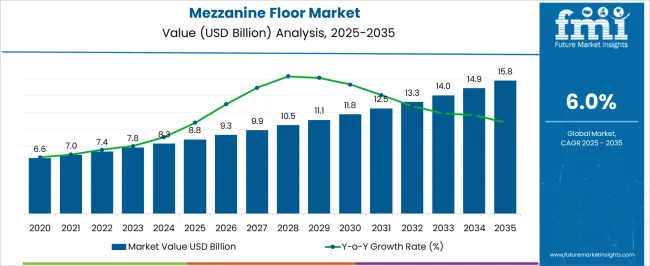
| Metric | Value |
|---|---|
| Mezzanine Floor Market Estimated Value in (2025 E) | USD 8.8 billion |
| Mezzanine Floor Market Forecast Value in (2035 F) | USD 15.8 billion |
| Forecast CAGR (2025 to 2035) | 6.0% |
The market is currently experiencing widespread adoption across logistics, warehousing, retail, and manufacturing environments, as reflected in facility expansion updates, automation trends, and corporate infrastructure investments. The growing complexity of distribution networks, particularly in urban centers, has compelled businesses to invest in modular and scalable solutions such as mezzanine floors.
Key drivers include rising operational costs of warehousing, the need for efficient vertical space utilization, and the expansion of e-commerce fulfillment centers. Ongoing infrastructure modernization, supported by investment announcements and project implementation reports from logistics and real estate companies, is paving the way for future growth.
Advancements in steel structure fabrication, modular design systems, and flexible assembly techniques are also facilitating quicker deployment, further boosting market penetration.
The mezzanine floor market is segmented by floor type, construction area, application, and geographic regions. By floor type, the mezzanine floor market is divided into Freestanding Mezzanine, Rack-supported Mezzanine, and Concrete Mezzanine. In terms of construction area, the mezzanine floor market is classified into Indoor and Outdoor/Exterior. Based on application, the mezzanine floor market is segmented into E-commerce, Retail, 3PL, Manufacturing, F&B, Pharmaceutical/Healthcare, and Others. Regionally, the mezzanine floor industry is classified into North America, Latin America, Western Europe, Eastern Europe, Balkan & Baltic Countries, Russia & Belarus, Central Asia, East Asia, South Asia & Pacific, and the Middle East & Africa.
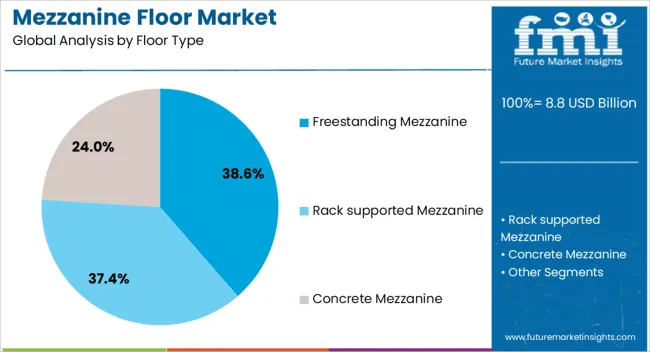
The freestanding mezzanine segment is projected to hold 38.6% of the mezzanine floor market revenue share in 2025, positioning it as the leading floor type. This segment’s dominance is being driven by its non-intrusive design, which enables independent installation without altering the primary building structure. Freestanding mezzanines are being widely adopted in warehouses and industrial spaces where flexibility, reusability, and ease of relocation are essential.
Facility planning reports and construction specifications highlight the appeal of this structure in enabling businesses to expand storage or workspace vertically without undergoing permanent construction. In addition, the adaptability of freestanding designs allows integration with conveyor systems, racking solutions, and safety components, which increases operational efficiency.
The cost savings achieved by avoiding structural modifications, combined with the speed of installation, have further supported its preference across various commercial sectors.
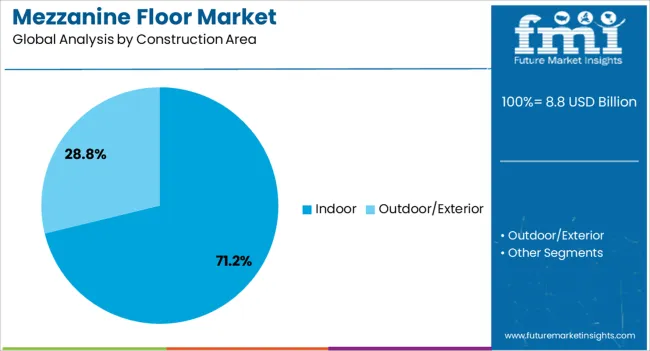
The indoor segment is anticipated to account for 71.2% of the mezzanine floor market revenue share in 2025, making it the dominant construction area category. This leadership is attributed to the widespread need for space maximization within enclosed facilities such as warehouses, production plants, and retail stores. Industry usage patterns and facility development plans suggest that indoor mezzanine structures are being favored for their ability to create multipurpose areas for storage, packaging, and administrative functions without expanding the building footprint.
The growing popularity of automation and robotics has further fueled the adoption of indoor mezzanines as an elevated zone support system integration and operational zoning. Their compatibility with HVAC systems, fire safety standards, and controlled environments also contributes to their extensive use across diverse industries.
The segment’s expansion is being reinforced by facility upgrade projects that require minimal disruption and compliance with structural safety regulations.
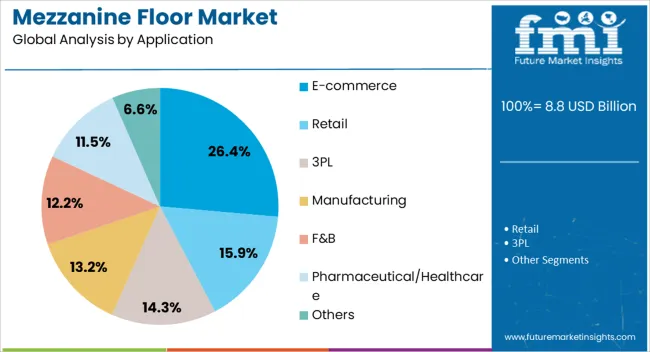
The e-commerce segment is expected to contribute 26.4% of the mezzanine floor market revenue share in 2025, establishing it as the top application area. This segment’s growth is being supported by the rapid expansion of online retail logistics networks and the proliferation of high-density distribution centers. Companies in the e-commerce sector are increasingly investing in mezzanine solutions to accommodate seasonal surges, facilitate order fulfillment, and improve inventory turnover rates.
Internal logistics plans and warehouse deployment updates highlight that mezzanine floors are enabling vertical optimization of floor space, allowing for multi-level storage and processing zones within constrained urban facilities. The need for rapid scalability, coupled with efficient layout flexibility, has further strengthened demand for mezzanines in this segment.
Additionally, indoor mezzanine installations align well with automation systems used in e-commerce fulfillment, such as sorters, pick-to-light systems, and conveyors. These operational advantages have solidified the e-commerce segment’s leadership in the application landscape of the mezzanine floor market.
Opportunities in modular and prefabricated systems are shaping the market, while challenges such as high initial costs and structural constraints remain barriers. By 2025, overcoming these obstacles through cost-effective, adaptable solutions will be essential for continued market expansion.
The mezzanine floor market is expanding due to the increasing demand for space optimization in commercial buildings. As businesses seek cost-effective solutions to maximize floor area in existing buildings, mezzanine floors offer a practical way to add storage or usable office space without the need for extensive renovations. By 2025, this demand for efficient space utilization will continue to drive market growth, particularly in sectors like retail, logistics, and industrial spaces where high-density storage is essential.
Opportunities in the mezzanine floor market are growing with the expansion of the retail and warehousing sectors. In retail, mezzanine floors are being increasingly used to expand floor space without incurring the cost of building new properties. Similarly, in warehouses, these floors are used to maximize vertical space, improving storage efficiency. By 2025, the ongoing expansion of these sectors will create significant demand for mezzanine floor solutions, allowing companies to utilize available space better and improve operational efficiency.
Emerging trends in the mezzanine floor market include the growing adoption of prefabricated and modular mezzanine floor systems. These solutions are being preferred due to their ease of installation, cost-effectiveness, and flexibility. Modular designs allow for easy customization and relocation, making them ideal for dynamic business environments. By 2025, the demand for modular and prefabricated mezzanine solutions will continue to rise as businesses look for scalable and versatile space solutions.
Despite growth, challenges related to high initial investment and structural constraints persist in the mezzanine floor market. Installing mezzanine floors requires significant upfront investment, especially for buildings with limited structural integrity. Additionally, building regulations and load-bearing capacity can pose limitations, particularly in older buildings. By 2025, addressing these challenges through innovative designs and cost-efficient solutions will be crucial to ensuring broader market adoption.
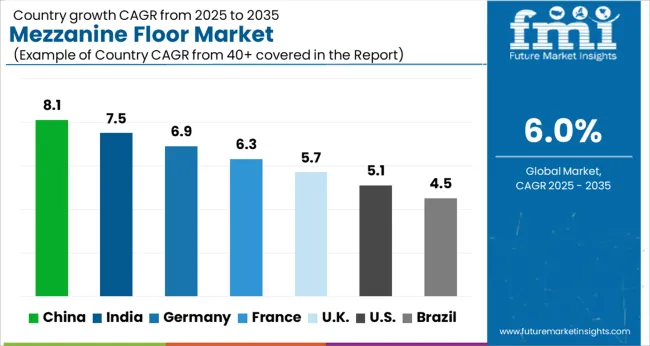
The global mezzanine floor market is projected to grow at a 6% CAGR from 2025 to 2035. China leads with a growth rate of 8.1%, followed by India at 7.5%, and Germany at 6.9%. The United Kingdom records a growth rate of 5.7%, while the United States shows the slowest growth at 5.1%. These varying growth rates are driven by factors such as increased demand for space optimization in commercial and industrial sectors, the rising trend of sustainable construction practices, and the need for cost-effective infrastructure solutions. Emerging markets like China and India are experiencing higher growth due to rapid urbanization, industrialization, and expansion in commercial real estate, while more mature markets like the USA and the UK see steady growth driven by innovation in construction methods and sustainability trends. This report includes insights on 40+ countries; the top markets are shown here for reference.
The mezzanine floor market in China is growing at a robust pace, with a projected CAGR of 8.1%. China’s rapid urbanization and industrial expansion, coupled with a growing demand for space optimization in commercial and industrial settings, are driving the demand for mezzanine floors. The country’s booming real estate sector and increasing focus on cost-effective, flexible building designs further contribute to market growth. Additionally, government support for sustainable construction practices, as well as growing investments in infrastructure development, further accelerates the adoption of mezzanine floors in both residential and commercial applications.
The mezzanine floor market in India is projected to grow at a CAGR of 7.5%. India’s expanding commercial real estate sector, coupled with the rising demand for space-efficient infrastructure in both industrial and retail sectors, is driving the demand for mezzanine floors. The country’s rapid urbanization, growth in e-commerce, and increasing need for multi-functional spaces in warehouses and storage facilities are contributing to market growth. Additionally, the increasing focus on sustainability in the construction industry, along with government initiatives to improve infrastructure, further accelerates the adoption of mezzanine floor solutions.
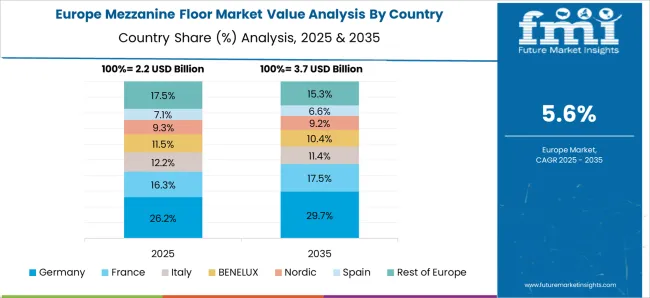
The mezzanine floor market in Germany is projected to grow at a CAGR of 6.9%. Germany’s strong manufacturing base, coupled with the growing demand for industrial space and multi-story commercial buildings, is driving steady demand for mezzanine floors. The country’s focus on energy-efficient construction and sustainable building practices, alongside increasing investments in logistics infrastructure, further boosts the demand for mezzanine floors. Germany’s advanced technology and construction methods also contribute to the development of high-performance mezzanine systems that meet the needs of the evolving industrial and commercial sectors.
The mezzanine floor market in the United Kingdom is projected to grow at a CAGR of 5.7%. The UK market is driven by increasing demand for flexible space utilization in the commercial and industrial sectors, particularly in warehouses and retail outlets. The country’s focus on sustainable construction and space optimization, coupled with the rise in e-commerce and the growing need for efficient storage solutions, is contributing to steady market growth. Additionally, the UK’s regulatory environment, which emphasizes energy efficiency and sustainability in building design, accelerates the adoption of mezzanine floors in commercial and industrial infrastructure.
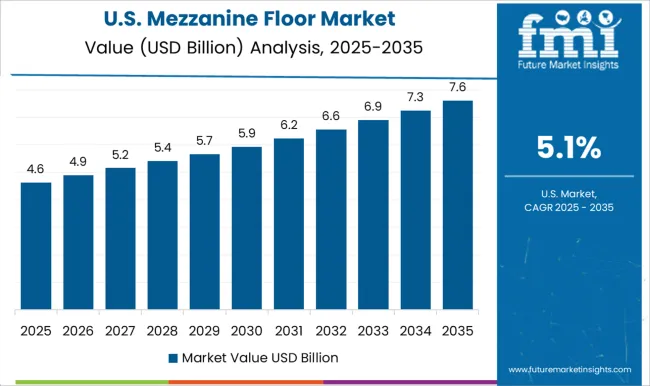
The mezzanine floor market in the United States is expected to grow at a CAGR of 5.1%. The USA market remains steady, driven by increasing demand for space-efficient solutions in commercial real estate and industrial facilities. The country’s growing e-commerce sector, coupled with the need for improved storage and warehouse space, is fueling the adoption of mezzanine floors. Additionally, the USA focus on sustainable construction and the growing preference for multi-functional spaces in warehouses, retail spaces, and offices continue to support steady market growth.
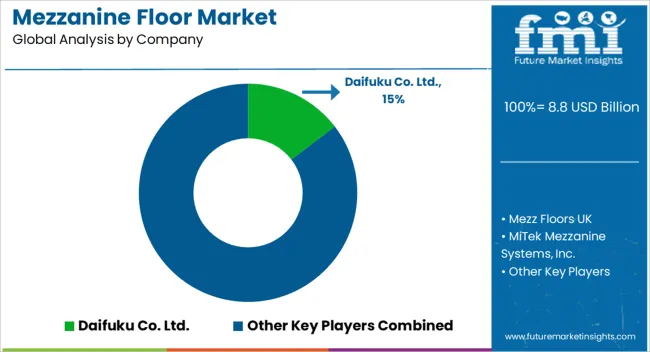
The mezzanine floor market is dominated by Daifuku Co. Ltd., which leads with its advanced mezzanine flooring systems designed for material handling, storage, and maximizing vertical space in warehouses, retail, and industrial sectors. Daifuku’s dominance is supported by its innovative designs, global reach, and strong customer relationships in the logistics and manufacturing industries. Key players such as MiTek Mezzanine Systems, Inc., Mecalux S.A., and SSI Schaefer Group maintain significant market shares by offering durable, customizable mezzanine solutions that improve warehouse efficiency, enhance storage capacity, and optimize floor space utilization. These companies focus on providing flexible, scalable systems tailored to meet the needs of diverse industries, including e-commerce, manufacturing, and retail. Emerging players like Mezz Floors UK, Wildeck Inc., and Avanta UK are expanding their market presence by offering specialized mezzanine systems designed for niche applications, such as modular office spaces, manufacturing facilities, and heavy-duty storage solutions. Their strategies include improving design flexibility, offering eco-friendly options, and providing cost-effective solutions for small and medium-sized enterprises.
Market growth is driven by increasing demand for efficient warehouse space utilization, the rise in e-commerce logistics, and the need for scalable storage solutions in industrial sectors. Innovations in modular designs, automated systems, and material handling integration are expected to continue shaping competitive dynamics and drive further growth in the global mezzanine floor market.
| Item | Value |
|---|---|
| Quantitative Units | USD 8.8 Billion |
| Floor Type | Freestanding Mezzanine, Rack supported Mezzanine, and Concrete Mezzanine |
| Construction Area | Indoor and Outdoor/Exterior |
| Application | E-commerce, Retail, 3PL, Manufacturing, F&B, Pharmaceutical/Healthcare, and Others |
| Regions Covered | North America, Europe, Asia-Pacific, Latin America, Middle East & Africa |
| Country Covered | United States, Canada, Germany, France, United Kingdom, China, Japan, India, Brazil, South Africa |
| Key Companies Profiled | Daifuku Co. Ltd., Mezz Floors UK, MiTek Mezzanine Systems, Inc., Mecalux S.A, STILL GmbH, Gonvarri Material Handling, Avanta UK, SSI Schaefer Group, Jungheinrich AG, Wildeck Inc, Abtech, Inc., Davicon Mezzanine Floors, MezzaTech, Stanley Black & Decker, Inc, and Stow International |
| Additional Attributes | Dollar sales by floor type and application, demand dynamics across commercial, industrial, and residential sectors, regional trends in mezzanine floor adoption, innovation in space optimization and modular designs, impact of regulatory standards on building safety and load-bearing capacity, and emerging use cases in flexible workspaces and warehouse solutions. |
The global mezzanine floor market is estimated to be valued at USD 8.8 billion in 2025.
The market size for the mezzanine floor market is projected to reach USD 15.8 billion by 2035.
The mezzanine floor market is expected to grow at a 6.0% CAGR between 2025 and 2035.
The key product types in mezzanine floor market are freestanding mezzanine, rack supported mezzanine and concrete mezzanine.
In terms of construction area, indoor segment to command 71.2% share in the mezzanine floor market in 2025.






Full Research Suite comprises of:
Market outlook & trends analysis
Interviews & case studies
Strategic recommendations
Vendor profiles & capabilities analysis
5-year forecasts
8 regions and 60+ country-level data splits
Market segment data splits
12 months of continuous data updates
DELIVERED AS:
PDF EXCEL ONLINE
Floor Screed Market Size and Share Forecast Outlook 2025 to 2035
Floor Standing Filtered Bottle Filling Stations Market Size and Share Forecast Outlook 2025 to 2035
Floor Cleaner Market Size and Share Forecast Outlook 2025 to 2035
Floor Transition Strips Market Analysis - Size, Share, and Forecast Outlook 2025 to 2035
Floor Scales Market Size and Share Forecast Outlook 2025 to 2035
Floor Lamp Market Size and Share Forecast Outlook 2025 to 2035
Floor Cleaning and Mopping Machine Market Size and Share Forecast Outlook 2025 to 2035
Floor Marking Tape Market Analysis - Size and Share Forecast Outlook 2025 to 2035
Flooring Market Size and Share Forecast Outlook 2025 to 2035
Floor Displays Market Growth from 2025 to 2035
Flooring and Carpets Market - Trends, Growth & Forecast 2025 to 2035
Floor Grinding Machine Market
Bus Flooring Market Growth – Trends & Forecast 2025 to 2035
Eco Flooring Market Analysis - Growth, Demand & Forecast 2025 to 2035
Gas Floor Fryers Market
Underfloor Heating Market Size and Share Forecast Outlook 2025 to 2035
Underfloor Air Distribution Systems Market
Vinyl Flooring Market Growth - Trends & Forecast 2025 to 2035
Pelvic Floor Diagnostics Market - Demand & Forecast 2025 to 2035
Pelvic Floor Stimulators Market – Trends & Forecast 2025 to 2035

Thank you!
You will receive an email from our Business Development Manager. Please be sure to check your SPAM/JUNK folder too.
Chat With
MaRIA